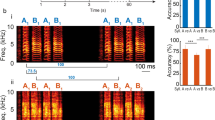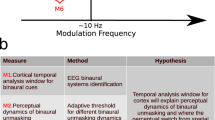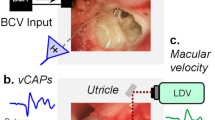Abstract
THE auditory systems of fishes have been of particular interest in the development of auditory theory because a mechanical analysis of frequency had seemed unlikely on the basis of the ear's rather undifferentiated structural organisation1. Thus, at the level of the 8th nerve, information about stimulus frequency is thought to be coded in the temporal structure of neural activity rather than in across-fibre distributions of impulse rate2–4. However, recent neurophysiological data show that a limited peripheral frequency analysis occurs in several species5–7 and some workers have suggested that this may form the basis for psychophysical demonstrations of filtering8–10 and for frequency discrimination in the fish auditory system11,12. Such a ‘place principle’ of frequency analysis and pitch perception is presently generally believed to originate in the phyletic series among the amphibia and to reach the greatest degree of elaboration with the mammals13. We report here an experiment which helps to resolve this question of frequency codings by evaluating the adequacy of the temporal hypothesis to account for the behaviourally measured frequency difference limens for the goldfish11,12. A simple form of the temporal coding hypothesis states that the reciprocal of stimulus frequency (period) is represented in 8th nerve fibres as the distribution of time intervals between phase-locked impulses4. A discrimination between two different period lengths may thus entail a decision as to whether the two resulting distributions of neural interspike intervals are the same or different. Clearly, the performance on such a discrimination would be limited by the variability of the distributions, or the accuracy with which neural impulses are phase-locked to the stimulating waveform. We demonstrate here that the neurones which phase-lock best at any given frequency show degrees of phase-locking accuracy that would be expected if the central nervous system were processing the input optimally.
This is a preview of subscription content, access via your institution
Access options
Subscribe to this journal
Receive 51 print issues and online access
$199.00 per year
only $3.90 per issue
Buy this article
- Purchase on Springer Link
- Instant access to full article PDF
Prices may be subject to local taxes which are calculated during checkout
Similar content being viewed by others
References
von Frisch, K. Z. vergl. Physiol. 25, 703–747 (1938).
Schwartzkopff, J. in Sound Reception in Fish (eds Shuijf, A. & Hawkins, A.) (Elsevier, Amsterdam, 1976).
van Heel, D. Experentia 15, 75–76 (1956).
Wever, E. G. Theory of Hearing (Wiley, New York, 1949).
Furukawa, T. & Ishii, Y. J. Neurophysiol. 30, 1377–1403 (1967).
Enger, P. S. Acta physiol. scand. 59, Suppl., 1–48 (1963).
Fay, R. J. acoust. Soc. Am. 63, 136–146 (1978).
Hawkins, A. & Chapman, C. J. comp. Physiol. 103, 209–226 (1975).
Tavolga, W. J. acoust. Soc. Am. 55, 1323–1333 (1974).
Popper, A. & Clarke, N. Comp. Biochem. Physiol. 53, 11–18 (1976).
Fay, R. R. J. comp. physiol. Psychol. 73, 175–180 (1970).
Jacobs, D. & Tavolga, W. Anim. Behav. 16, 67–71 (1963).
Wever, E. G. in Handbook of Sensory Physiology, Vol. 5 (eds Keidel, W. D. & Neff, W. D.) 423–454 (Springer, Berlin, 1974).
Fay, R. R. J. audit. Res. 9, 112–121 (1969).
Rose, J., Brugge, J., Anderson, D. & Hind, J. J. Neurophysiol. 30, 769–793 (1967).
Anderson, D. J. acoust. Soc. Am. 54, 361–364 (1973).
Gumble, E., Greenwood, J. & Durand, D. J. Am. statist. Ass. 48, 131–152 (1953).
Mountcastle, V., Sakata, H., Talbot, W. & Hyvarinen, J. J. Neurophysiol. 32, 452–484 (1969).
Green, D. & Swets, J. in Signal Detection Theory and Psychophysics (Kreiger, New York, 1974).
Fay, R. J. acoust. Soc. Am. 62, 588 (1977).
Author information
Authors and Affiliations
Rights and permissions
About this article
Cite this article
FAY, R. Phase-locking in goldfish saccular nerve fibres accounts for frequency discrimination capacities. Nature 275, 320–322 (1978). https://doi.org/10.1038/275320a0
Received:
Accepted:
Issue Date:
DOI: https://doi.org/10.1038/275320a0
This article is cited by
-
Encoding properties of auditory neurons in the brain of a soniferous damselfish: response to simple tones and complex conspecific signals
Journal of Comparative Physiology A (2009)
Comments
By submitting a comment you agree to abide by our Terms and Community Guidelines. If you find something abusive or that does not comply with our terms or guidelines please flag it as inappropriate.



